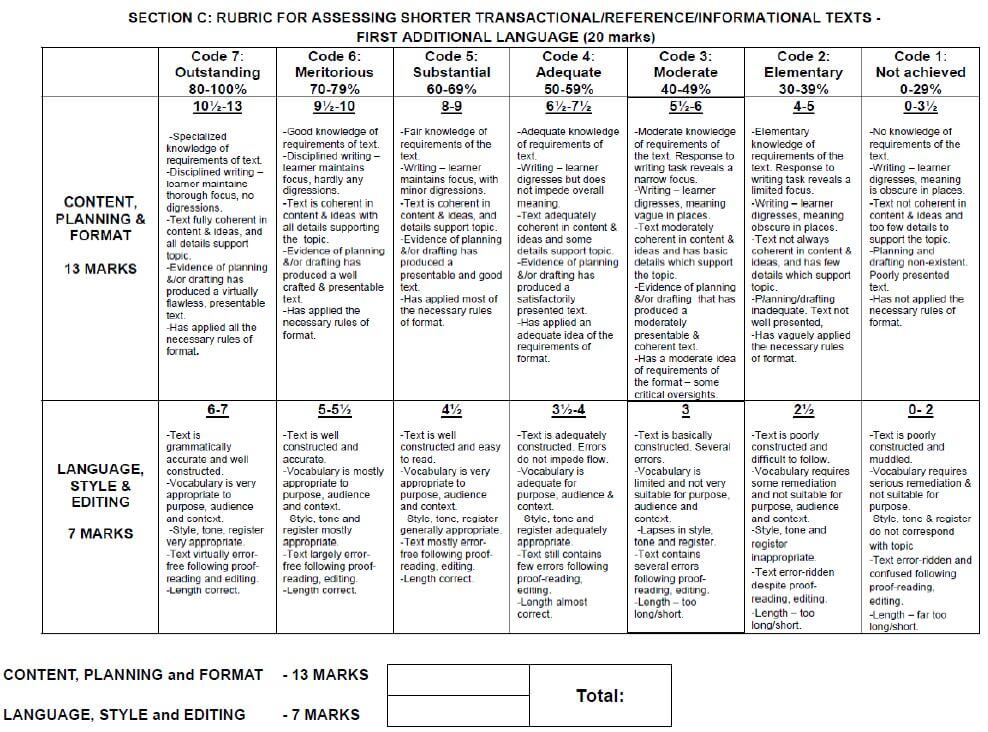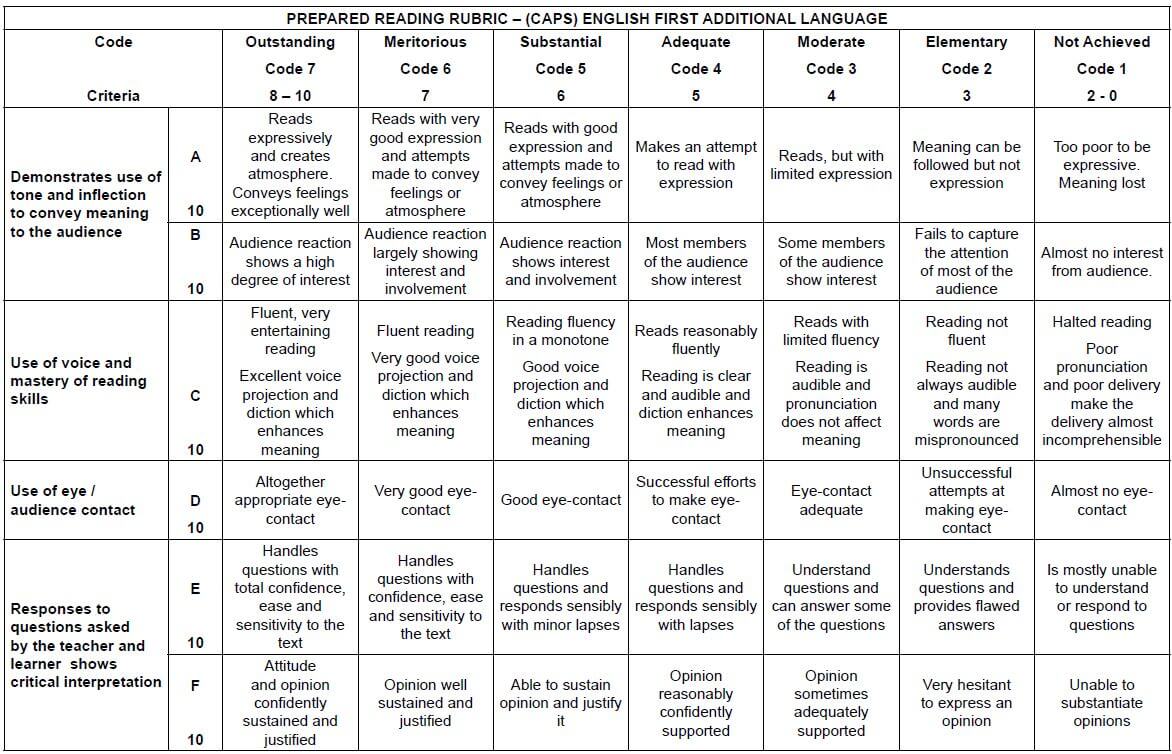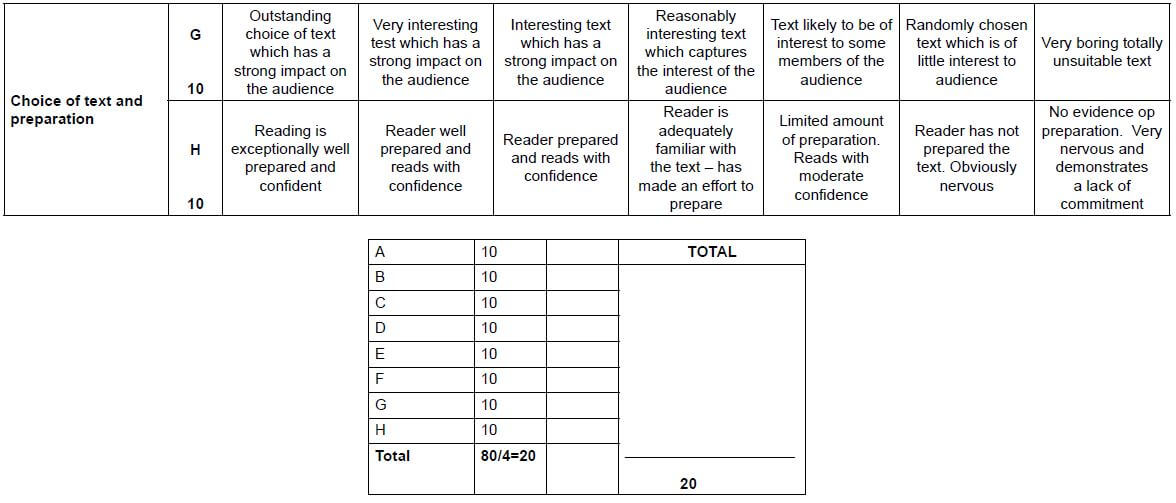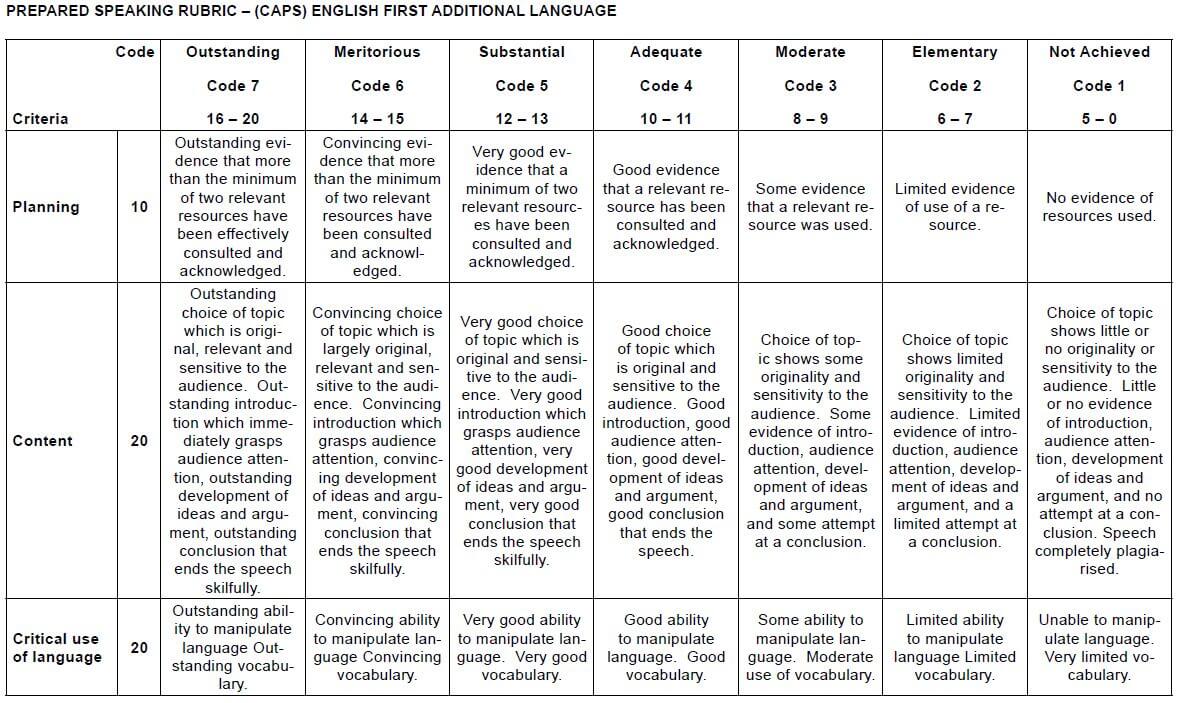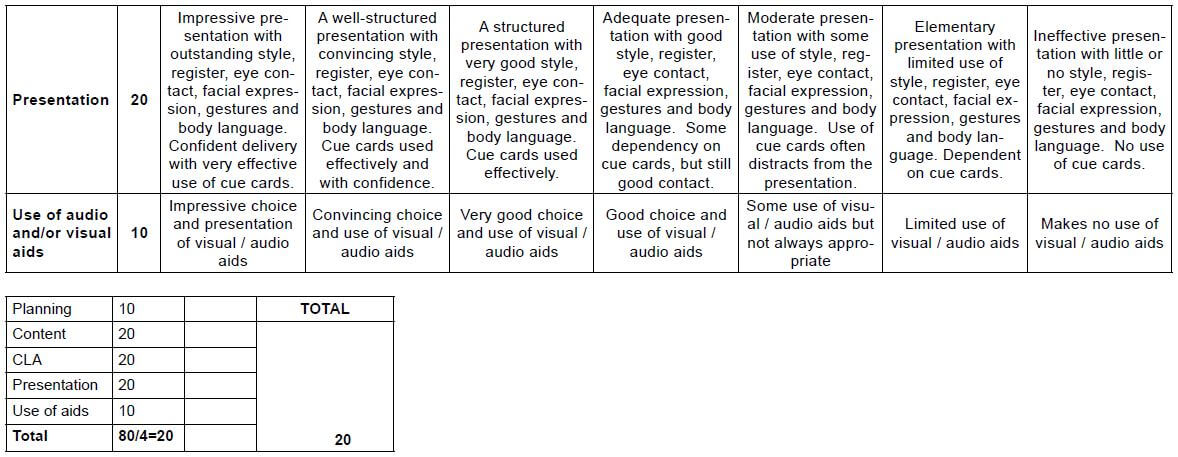ENGLISH FIRST ADDITIONAL LANGUAGE SCHOOL BASED ASSESSMENT EXEMPLARS - CAPS GRADE 12 TEACHER'S GUIDE
Share via Whatsapp Join our WhatsApp Group Join our Telegram GroupENGLISH FIRST ADDITIONAL LANGUAGE
SCHOOL BASED ASSESSMENT EXEMPLARS - CAPS
GRADE 12
TEACHER'S GUIDE
| TABLE OF CONTENTS | ||
| CONTENTS | PAGE | |
| 1 | Introduction | 6 |
| 2 | Aims and Objectives of School-based Assessment | 7 |
| 3 | Programme of Assessment | 9 |
| 4 | Assessment Tasks | 10 |
| a | Term 1 | |
| How to administer a formal listening comprehension task | 8 | |
| Task 1 – Exemplar 1: Listening comprehension | 9 | |
| Task 1 – Exemplar 2: Listening comprehension | 11 | |
| How to administer an essay | 13 | |
| Task 2 – Exemplar 1: Writing an essay | 14 | |
| Task 2 – Exemplar 2: Writing an essay | 16 | |
| Task 2 – Exemplar 3: Writing an essay | 18 | |
| How to administer a longer transactional task | 20 | |
| Task 3 – Exemplar 1: Writing a longer transactional task | 21 | |
| Task 3 – Exemplar 2: Writing a longer transactional task | 23 | |
| Task 3 – Exemplar 3: Writing a longer transactional task | 24 | |
| b | Term 2 | |
| How to teach and assess reading aloud | 26 | |
| Task 5 – Exemplar 1: Oral: Prepared reading | 27 | |
| Task 5 – Sample reading passages | 28 | |
| How to teach and assess a prepared speech | 34 | |
| Task 6 – Exemplar 1: Oral: Prepared speech | 35 | |
| c | Term 3 | |
| How to administer a shorter transactional task …. | 36 | |
| Task 9 – Exemplar 1: Writing a shorter transactional task | 37 | |
| Task 9 – Exemplar 2: Writing a shorter transactional task | 39 | |
| 5 | Marking Guidelines | 44 |
| Task 1 – Exemplar 1: Listening comprehension | 44 | |
| Task 1 – Exemplar 2: Listening comprehension | 45 | |
| Task 2 – Essay: General marking guidelines and instructions | 46 | |
| Task 2 – Sample: Essay | 47 | |
| Task 3 – Longer transactional tasks: General marking guidelines | 48 | |
| Task 3 – Exemplar 1: Longer transactional tasks | 49 | |
| Task 3 – Exemplar 2: Longer transactional tasks | 51 | |
| Task 3 – Exemplar 3: Longer transactional tasks | 53 | |
| Task 3 – Sample: Longer transactional task: Restaurant review | 54 | |
| Task 9 – Shorter transactional tasks: General marking guidelines | 55 | |
| Task 9 – Exemplar 1: Shorter transactional task | 56 | |
| Task 9 – Exemplar 2: Shorter transactional task | 57 | |
| Task 9 – Sample: Shorter transaction task: Diary entry | 58 | |
| 6 | Rubrics | 61 |
| Essay | 59 | |
| Longer Transactional Task | 60 | |
| Shorter Transactional Task | 61 | |
| Prepared Reading | 62 | |
| Prepared Speaking | 63 | |
1. Introduction
“School-based assessment is a purposive collection of learners’ work that tells the story of the learners’ efforts, progress or achievement in given area(s).”
This exemplar booklet serves as a guide to schools and subject teachers on how to administer school-based assessment (SBA) for English First Additional Language from 2014.
School-based assessment is an integral part of learners’ preparation for the final examinations. Their school-based assessment mark is formally recorded by you, the teacher, for progression and certification purposes.
These formal assessment tasks provide you with a systematic method of evaluating how well learners are progressing and this guideline includes various assessment tasks such as tests, examinations, writing tasks, oral presentations and listening comprehension.
School-based assessment is compulsory for all learners. If learners cannot comply with the requirements specified according to the policy, they may not be eligible to enter for the subject in the final examination.
Formal assessment tasks form part of a year-long formal programme of assessment. These tasks should not be taken lightly and learners should be encouraged to submit their best possible efforts for final assessment.
Remember to keep your assessment relevant to and suitable for the learners you teach. Adapt the tasks to suit your particular needs, remembering keeping in mind however, that you are guided by the requirements as set out in the CAPS. policy document.
2. Aims and objectives of school-based assessment
- School-based assessment provides a more balanced and trustworthy assessment system, increasing the range and diversity of assessment tasks.
- It improves the validity of oral language assessment in particular, by including aspects that cannot be assessed in formal examination settings.
- It improves the reliability of assessment because judgements are based on many observations of the learners over an extended period.
- There is a beneficial effect on teaching and learning, particularly in relation to not only the development of speaking, extensive reading and writing skills, but also on teaching and assessment practices.
- It empowers teachers to become part of the assessment process and enhances collaboration and sharing of expertise within and across schools.
- It has a professional developmental function, namely, building up practical skills in teacher assessment which can then be transferred to other areas of the curriculum.
The distinctive characteristics of SBA (and its strengths as one relatively small component of a coherent assessment system) have implications for its design and implementation, in particular the nature of the assessment tasks and role of the teachers’ standardisation procedures. These implications are summarised as follows:
- The assessment process should be linked to and be a logical outcome of the normal teaching programme, as teaching, learning and assessment should be complementary parts of the whole educational experience (i.e. the SBA component is not a separate one-off activity that can be timetabled or prepared for as if it were a separate element of the curriculum).
- The assessment process should provide a richer picture of what learners can do than the external examination by taking more samples over a longer period of time and by more closely approximating real-life and low-stress conditions (i.e. the SBA component is not a one-off activity done under pseudo-exam conditions by unfamiliar assessors).
- The focus of the assessment tasks should be on the speaking, reading and writing ability of the students, including their ability to discuss issues in depth and convey their ideas clearly and concisely (i.e. the SBA component is not an assessment of the students’ memorisation skills, nor of their ability to provide highly specific factual details about what they have read or viewed).
- The formative/summative distinction exists in SBA, but is much less rigid and fixed than in a testing culture, i.e. students should receive constructive feedback and have opportunities to ask questions about specific aspects of their progress after each planned SBA assessment activity, which both enhances language development and helps students prepare for the final external examination (i.e. the SBA component is not a purely summative assessment).
- The marking criteria and standards should be regularly discussed with learners and actively used by them, albeit in adapted form, as part of self and peer-assessment for formative purposes.
- The assessment tasks are designed as formal moments in the teaching programme at which the teachers can stand back and reflect on their implicit or explicit assumptions about individual learners’ capacities, compare these assumptions with careful analysis of examples of students’ real performance, and then subject their judgements to explicit scrutiny and challenge or confirmation by others (i.e. the SBA component does not assume that the teacher is totally objective and/or has no pre-conceived ideas or assumptions about a learner’s level; rather, it seeks to make such assumptions explicit and open to discussion with fellow teachers).
- The SBA process, to be effective, has to be highly contextualised, dialogic and sensitive to learners’ needs (i.e. the SBA component is not and cannot be treated as identical to an external exam in which texts, tasks and task conditions are totally standardised and all contextual variables controlled; to attempt to do so would be to negate the very rationale for SBA; hence schools and teachers must be granted a certain degree of trust and autonomy in the design, implementation and specific timing of the assessment tasks).
Teachers should ensure that students have read and understood the assessment criteria and have extensive experience of using it for self and peer-assessment in informal situations before conducting a planned assessment activity. Teachers should also have used these criteria for informal assessment and teaching purposes before they conduct any formal assessment so that they are familiar with the criteria and the assessment process.
3. Programme of Assessment
Term 1 | Task 1 | Task 2 | Task 3 | Task 4 | ||
Oral: | Writing: | *Writing: | **Test 1: | |||
Total: | 10 | 50 | 30 | 40 | ||
Term 2 | Task 5 | Task 6 | Task 7 | Task 8 | ||
Oral: | Oral: | Literature: | ****Mid-year examinations | |||
Total: | 20 | 20 | 35 | 250 | ||
Term 3 | Task 9 | Task 10 | ||||
***Writing: Shorter transactional writing | ****Preparatory examinations | |||||
Total: | 20 | 250 | ||||
* Friendly/Formal letters (request/complaint/application/business)/formal and informal letters to the press/ curriculum vitae and covering letter/obituary/agenda and minutes of meeting/report/review/newspaper article/magazine article/dialogue/ interview.
** Test 1 should be set out of 40 marks or, if more, should be converted to 40 marks. While the Comprehension, Summary, Language structures and conventions combination is suggested, teachers are urged to design a combination of aspects that fits the character (test programme, time allocation, etc.) of the school. A test in the Programme of Assessment should not be made up of several smaller tests. Each test should cover a substantial amount of content, should be set for 45–60 minutes, and should reflect the different cognitive levels as set out for exam papers.
*** Advertisements/Diary entries/Postcards/Invitation cards/Filling in forms/ Directions/Instructions/Flyers/Posters/ emails.
**** Mid-year and Trial examinations: In Grade 12 one of the tasks in Term 2 and/or Term 3 (Tasks 8 and/or 10) must be an internal examination. In instances where only one of the two internal examinations is written in Grade 12, the other examination could be replaced by a test. A recommendation has been made that the written test, if this option is chosen, should be set out of 80 marks. This test should take the format of the Language structure and conventions, as set in the examinations.
4. Tasks
a. Term 1
Being able to listen well is an important part of communication for everyone. For our students, guided practice by a teacher is one of the best ways to improve this skill. A student with good listening comprehension skills will be able to participate more effectively in communicative situations. Teaching the skill of listening cannot be emphasised enough in a communicative classroom. For First Additional Language learners, developing the skill of listening comprehension is extremely important.
When the learning objective of a language class is explained to students, they can focus better on specific vocabulary acquisition, grammar practice, listening for different purposes, and so on. This clear explanation by the teacher of a lesson’s pedagogic goals will help learners to further develop specific objectives in a shorter amount of time. For instance, by informing students that the lesson will be about giving directions, they can consciously focus on remembering the vocabulary used in that activity.
It is important to maintain an interactive and communicative approach for teaching English as a first additional language. However, it is also important to vary the students’ learning focus by concentrating on the skills needed to become proficient in a second language. Listening comprehension is one such a required skill.
When designing lessons and teaching materials to further develop listening comprehension skills, students need to be motivated and stay motivated. This is best accomplished by determining the suitability of the listening materials, the techniques used in classroom teaching, and the use of authentic materials. Two sample listening comprehension tasks have been developed for your convenience.
How to administer a formal listening comprehension task:
- Supply learners with a blank page.
- Alert learners to the type of information they will be required to listen for and to demystify (give some background on) the passage.
- The listening passage for Grade 12 should be approximately 350 words in length.
- The text to be read, at least two times.
- During the first reading the teacher should read through the text so learners can become familiar with the content. (Hint: The teacher can pre-record the passage; record a good reader reading the passage.) During this time learners should listen only and may NOT WRITE.
- During the second reading, the text should be read at normal pace. During this reading, learners may make listening notes.
- After the second reading, learners should be given the questions and ample time to answer questions in full sentences.
- Ensure that the questions and the requirements of the questions are understood by all.
- The listening comprehension questions set must follow the requirements of Barrett’s Taxonomy.
Task 1 – Exemplar 1: Listening Comprehension
UP, UP AND AWAY
Matt Silver-Vallance will be strapping himself to 200 helium-filled party balloons and flying – yes, flying – from Robben Island to the mainland.
Charity and children are two things very close to the hearts of many South Africans. It’s rare, however, that you’ll find an individual willing to risk his or her life for the cause. For Matt Silver-Vallance, the Nelson Mandela Children’s Hospital is worth a daring stunt – a flight from Robben Island to the mainland over shark-infested waters with only a bunch of helium balloons to keep him up in the air.
“Balloons represent a child who is healthy and happy,” Matt explains. “My best friend Steve and I actually had the idea before the movie UP so it’s always a bit of a laugh because people say, ‘Oh, like the movie’ and I want to say, ‘No, we had the idea first.’” While this flight is not as daring as a whole house flying across the skies, there are still some concerns. Matt laughs and says that one of the major worries is the weather. “In April we may get consistent south-easterlies which would take me to the Caribbean.” But the real concern for the light-hearted dad who has a bountiful sense of humour is that they won’t reach enough people and that the stunt won’t be as effective as it has the potential to be.
The first ever cluster-ballooning flight in Africa, Matt’s aim is to raise R10 million for the hospital. He has been planning the stunt for over four years. The Cape Town-born daredevil became familiar with the children’s hospital in his early 20s while working as a volunteer paramedic for the Western Cape Ambulance Service. Although he now lives in the UK and has gone down a different career path, the need for paediatric care in South Africa is an issue he has never forgotten. “I chose the Nelson Mandela Children’s Hospital because a happy child is a wonderful thing and an unhealthy child can be a terrible thing to witness. My experience as a paramedic taking children to the Red Cross Children’s Hospital inspired me.” Oddly enough, he doesn’t consider it a challenge as he says laughing, “It should be very easy. I’ll be relaxing in my harness, floating over Table Bay looking at the beautiful Table Mountain.” (364 words)
[Source: Indwe Magazine, April 2013]
Listening Comprehension
Name: _______________________ Grade: _______________________
Date: _______________________
- Where will Matt start his stunt? (1)
- Why did Matt choose balloons to perform this stunt? (1)
- Matt’s idea to use balloons is original. Do you agree? Give a reason for your answer. (1)
- Give an explanation of Matt’s intention in doing this stunt. (2)
- Give one reason why this stunt could be dangerous. (1)
- Matt is described as a “daredevil”. Explain this word in the context of the article. (2)
- In your view, is Matt an irresponsible person? Substantiate your answer. (2)
TOTAL: 10
Task 1 – Exemplar 2: Listening Comprehension
PUT AN END TO BULLYING
(This article appeared in a magazine for teachers called What’s up Teach?)
We all know that children learn best in an environment where they feel safe and secure. Many children don’t learn because they come to school fearful of being bullied. Unfortunately, there’s no single solution that will stop or prevent bullying. What’s Up Teach? interviewed two school principals to find out what they have done to reduce bullying in their schools.
WHAT IS BULLYING? It is the repeated behaviour by an individual or group that intentionally hurts another individual or group either physically or emotionally. Often bullying is motivated by some prejudice or other against particular groups or by actual or perceived differences between children. Emotional bullying can be hard to identify and can be very damaging to children. |
Mrs Moima told us that she had received a number of complaints from parents that their children were being bullied.
“We decided to be proactive,” says Mrs Moima.
“We held a workshop and we spoke about what issues could result in bullying and we developed strategies to prevent bullying. We needed to change the culture to one where pupils treat one another and the school staff with respect.
Not an easy task! We asked Mrs Moima what they did.
WE HELD A POSTER COMPETITION “Groups of learners designed posters on good values in the school, to show the importance of respect for staff and other pupils. The children set up a jury to judge the posters. This actually became an advocacy campaign that helped to permeate the values of respect and care throughout the whole school environment.” |
Mrs Moima tells us they introduced the following school rules specifically to deal with bullying:
- Don’t bully other children.
- Try to help pupils who are being bullied.
- Include children who might be left out.
- Encourage the practice of “Ubuntu” and caring in the school.
They also introduced ways of dealing with aggressive behaviour:
- Bullies had to apologise.
- They had to forfeit their breaks and do some “community service”.
- Bullying incidents were discussed with their teacher, principal and parents.
(333 words)
Listening Comprehension
Name: _________________________ Grade: _________________________
Date: _________________________
- What does bullying mean, according to the passage? (1)
- Mrs Moima decided to be proactive about bullying at her school. Name any ONE action she took to prevent bullying from taking place. (1)
- Name TWO of the rules that Mrs Moima introduced at the school to deal with bullying. (2)
- What is the intention of publishing an article like this one in an educational magazine? Give TWO possible answers. (2)
- Why would prejudice be one of the causes of bullying? (1)
- What effect did the poster competition have on the school? (1)
- How effective do you think forfeiting breaks and doing community service would be as punishment for aggressive behaviour in your school? Give a reason for your answer. (2)
TOTAL: 10
How to administer an essay
Learners should be familiar with the following types of essays:
- Narrative – to entertain or tell a story
- Descriptive – to describe in a vivid manner
- Discursive – to present arguments from differing viewpoints and draw a clear conclusion of your own
- Argumentative – to argue a case for one side of a point to convince your reader of your opinion
- Reflective – to give your emotional reaction on a specific matter
General teaching guidelines and instructions
- Guide learners on how to choose the correct topic.
- Emphasise the importance of process writing. Learners should first plan, using a method that they are comfortable with, i.e. mind mapping, brainstorming, free writing, etc.
- Learners must write a draft. Guide learners on how to edit their draft. The final product should not be a carbon copy of the draft.
- Remind learners of the conventions of essay writing.
- Deter learners from writing on inappropriate content or using inappropriate language.
Task 2 – Writing: Essay
In order to write well, you need knowledge of different text types, a wide vocabulary, a good control of English grammar, spelling and punctuation, and a critical understanding of the potential effects of your writing.
An essay is an extended piece of writing, in which a writer expresses his/ her point of view on the topic given. An essay should have an introduction, body and conclusion. A brief explanation of each follows:
Introduction
The introduction should catch the reader’s attention, define the topic and briefly tell the reader what the essay will be addressing.
Body
The body comprises the full content of the essay. The body must be divided into paragraphs, each of which must pursue a specific idea to the end. The writer must address all the ideas he or she wanted to address, keeping to the topic.
Conclusion
The conclusion is the ending, the rounding-off of the presentation. This should tie up all that was presented by the writer, a parting shot that justifies the writer’s point of view. As this is the end, the writer must not bring in new information.
Task 2 – Exemplar 1: Writing: Essay
Name: ____________________________ Grade: ______________
Date of submission: ____________________
INSTRUCTIONS
- Write an essay of between 250 and 300 words on any ONE of the following topics.
- Write down the question number correctly and supply a suitable title where required to do so.
- Remember that you have to show all the steps in your writing process.
- Your essay will be assessed according to the attached rubric.
TOPICS
- Can we still trust and look up to our sporting heroes to be the best role models that they can be? Discuss.
- Music is a part of every culture and plays different roles in people’s lives. Write about how the role music plays a role in your culture or in your own life.
- Teens love to talk: they love to talk online, on the air, on the phone, at school, after school, at the mall, in the car, behind their friends’ backs – what on earth do they talk about?
- Write an essay in which the following words appear:
Then I realised that a mirror reflects only what is on the outside and not who you are on the inside... - English should be the only language of teaching and learning in South African schools. Do you agree?
- The day I saw red ...
- Look at the pictures below. Use any ONE of them to write your essay. There should be a clear link between the picture and your essay.
7.1
[Source: Google image]
7.2
[Source: http://www.lifelonghappiness.com]
TOTAL: 50
Task 2 – Writing: Essay
Exemplar 2
Name: ____________________________ Grade: ______________
Date of submission: ____________________
INSTRUCTIONS
- Write an essay of between 250 and 300 words on any ONE of the following topics.
- Write down the question number correctly and supply a suitable title where required to do so.
- Remember that you have to show all the steps in your writing process.
- Your essay will be assessed according to the attached rubric.
TOPICS
- Every love story is beautiful, but this one is my favourite.
- Imagine you are 60 or 70 years old. Give your views about the teenagers of today.
- School does not prepare you for the real world. Discuss.
- Write an essay in which the following words appear: “It was dark and quiet and I had a feeling that all hell was about to break loose …”
- Technology such as computers, cellphones, PlayStations, Xbox and iPads are destroying the future generation of sporting stars. Do you agree?
- Memories of home.
- Look at the pictures below. Use any ONE of them to write your essay. There should be a clear link between the picture and your essay.
7.1
[Source: Google image]
7.2
[Source: Google image]
TOTAL: 50
Task 2 – Writing: Essay
Exemplar 3
Name: ____________________________ Grade: ______________
Date of submission: ____________________
INSTRUCTIONS
- Write an essay of between 250 and 300 words on any ONE of the following topics.
- Write down the question number correctly and supply a suitable title.
- Remember that you have to show all the steps in your writing process.
- Your essay will be assessed according to the attached rubric.
TOPICS
- Mistakes are proof that you are trying.
- If you could have any two famous people as your parents, who would you choose and why?
- “You don’t have to hold a position in order to be a leader.”
~Anthony J D’Angelo
Discuss. - Start your essay with the following words:”The doorbell rings. The door opens and a package is found on the front porch. A voice shouts, We’ve got another one!” Tell the rest of this story.
- Where do you go when you want to get away from the pressures of life, family and school? Write about that place.
- Good teaching in school hours will make homework unnecessary. Do you agree?
- Look at the pictures below. Use any ONE of them to write your essay. There should be a clear link between the picture and your essay.
7.1
[Source: Google image]
7.2
[Source: Google image]
TOTAL: 50
How to administer a longer transactional task
Learners should be familiar with all the types of transactional formats as prescribed in the policy documents.
- Friendly and formal letters (request, complaint, application, business)
- Formal and informal letters to the press
- Curriculum vitae and covering letter
- Obituary, agenda and minutes of meeting
- Report
- Review
- Newspaper article
- Magazine article
- Dialogue
- Interview
- Speech
- Guide learners on how to choose the correct topic.
- Emphasise the importance of process writing. Learners should plan first, using a method that they are comfortable with, i.e. mind mapping, brainstorming, free writing, etc.
- Learners must write a first draft. Guide learners on how to edit their draft. The final product should not be a carbon copy of the draft.
- Remind learners of the required formats for completion of these tasks.
- Remind learners that each transactional writing task requires a specific tone and register according to the intended audience.
- Deter learners from writing on inappropriate content or using inappropriate language.
Task 3 – Exemplar 1 : Writing a longer transactional task
Name: ____________________________ Grade: ______________
Date of submission: ____________________
INSTRUCTIONS
- Write a response to any ONE of the following topics.
- The content of your response should be between 120 and 150 words in length.
- Write down the question number and heading of the text you have chosen, for example 1. Friendly Letter.
- Remember that you have to show all the steps in your writing process.
- Pay particular attention to format, language, register and audience.
- Your piece will be assessed according to the attached rubric.
TOPICS
- Friendly Letter
You attended a concert. Write a letter in which you describe your experience to a friend who could not attend the concert. - Interview
You have the opportunity to interview any celebrity of your choice. Write down the interview. - Minutes
Your youth group has decided to raise funds in order to assist a local charity organisation to buy blankets and food for the less-privileged families.
The first meeting took place and you were the secretary of the meeting. The last three matters to be discussed under the agenda point “New Matters” were:- Fund-raising activities
- Selection of charities to receive the blankets and food
- Assigning of duties
Write the part of the minutes that reflects only the discussion on the three points above. Do NOT include details of the rest of the meeting.
- Formal Report
The principal of your school would like to encourage the use of cellphones to improve learning in the classroom. He has requested you, as a member of the Representative Council of Learners (RCL), to investigate this possibility. Write a formal report in which you record your findings and recommendations. - Letter of Formal Request
Write a well-motivated formal letter to the Mayor of your local municipality in which you request that an empty field in your neighbourhood be changed into a playground for local children.
TOTAL: 30
Task 3 – Exemplar 2 : Writing a longer transactional task
Name: ____________________________ Grade: ______________
Date for submission: ____________________
INSTRUCTIONS
- Write a response to any ONE of the following topics.
- The content of your response should be between 120 and 150 words in length.
- Write down the number and heading of the text you have chosen, for example 1. Letter of complaint.
- Remember that you have to show all the steps in your writing process.
- Pay particular attention to format, language, register and audience.
- Your piece will be assessed according to the attached rubric.
TOPICS
- Letter of complaint
While out walking your dog, you fell over the root of a tree that had grown through the pavement. You cut your knees badly and sprained an ankle and a wrist. Write a letter of complaint to a member of the local municipality complaining about the state of the pavements in your neighbourhood. - Dialogue
You arrive home from a party at 03:00, having promised your parents you would be in by 23:30. You overhear a conversation between your parents as you are sneaking in. Write out this conversation in dialogue form. - Newspaper article
Write a newspaper article for ONE of the following headlines:- Student caught red-handed
- Illegal connection kills boy
- Facebook causes breakup
- Informal Report
You were an eyewitness to an act of vandalism in your community.
Your parents have asked you to write an informal report to a community leader in which you report what you have witnessed. - Speech
Write a speech in which you encourage learners in your school to become involved in school projects. Entitle your speech:
“If not you, then who?”
TOTAL: 30
Task 3 – Exemplar 3: Writing a longer transactional task
Name: ____________________________ Grade: ______________
Date for submission: ____________________
INSTRUCTIONS
- Write a response to any ONE of the following topics.
- The content of your response should be between 120 and 150 words in length.
- Write down the number and heading of the text you have chosen, for example 1. Letter of complaint.
- Remember that you have to show all the steps in your writing process.
- Pay particular attention to format, language, register and audience.
- Your piece will be assessed according to the attached rubric.
TOPICS
- Letter to the press
Read the following letter that appeared in your local newspaper. Write a letter to the editor in which you express your views about the cited practice. You may agree or disagree with the viewpoints expressed in the letter.I am writing this letter about dogs being seen in all stores in shopping carts. I understand there are service animals (for blind people) but now people take their animals wherever they please. I put my food items in these carts as well as my 1-year-old granddaughter. I was at my eye doctor yesterday and they had a sign on the door that said NO PETS PLEASE. These signs should be placed in all stores. Mind you, I love animals myself but it is now being blown out of proportion.
From: Animals-at-home
- Magazine article
Write an article that will appear in a teen magazine. Use ONE of the following topics:- Cheating at school
- Resolving teacher-learner conflict
- How to deal with disappointing marks
Provide a suitable title for the article.
- Review
Your favourite artist has released a new CD. You have been asked to review this CD for your school newspaper. Write the review. - Letter of thanks
You lost your wallet with your ID book and some cash in it. Two weeks later your received a package in the mail. Someone had found your wallet and posted it back to you. When you opened the wallet all your belongings were still there.
Write a letter of thanks to the person who picked up your wallet and returned it.
TOTAL: 30
b. Term 2
How to teach and assess reading aloud
Spend some time preparing your learners for this section of the work. It is possible for all learners to achieve good marks in this section as they have the opportunity to prepare themselves ahead of time.
Stress the importance of choosing the passage. They must be at Grade 12 level, but also not too difficult for the learners to manage. They must be passages on topics that capture the learners’ interest, as they will then naturally read better. They must be long enough for the educator to be able to make a fair assessment.
There must be clear evidence of preparation. The learners must have found out the meanings and pronunciation of all the words in the passage.
Encourage learners to enhance the meaning of words through tone, voice projection, pace, eye contact, posture and gestures.
You may wish to add to your conversation assessment by asking the learners’ questions on the passages after the prepared reading has been completed.
Do not force learners who stutter or who experience other speech impediments to perform in the front of the class if they would rather not. Allow them to work alone with you at a pre-arranged time.
Use the rubric in the addendum to assess prepared reading. Discuss the rubric with the learners so that they know how they will be assessed.
Task 5 – Exemplar 1: Oral: Prepared Reading
Date of submission: ____________________________________
Prepare a reading piece for oral assessment. Your reading should be TWO to THREE minutes long. Carefully follow the instructions:
- Take some time to select a suitable passage that you enjoy reading.
- Read it silently to yourself to familiarise yourself with its contents.
- Then read it aloud several times. When you feel that you have mastered it, read it in front of the mirror, looking at yourself several times during the reading. If you can do this, it means that you will look up at your audience several times during the reading.
- You might also like to read to a willing audience for practice.
- You will need to project your voice and read with good pace.
- Maintain good posture and eye contact as you read.
- Practise pronouncing all the words correctly.
- Remember that you will be required to answer questions about the passage you have read.
TOTAL: 10
Sample: Reading passages
SAMPLE PASSAGE 1
As I had expected, it turned out to be quite a business. I had to notify the police as well as the health authorities, and answer a lot of tedious questions: How was it I was ignorant of the boy’s presence? If I did not supervise my native quarters, how did I know that that sort of thing didn’t go on all the time? Et cetera, et cetera. And when I flared up and told them that so long as my natives did their work, I didn’t think it my right or concern to poke my nose into their private lives, I got from the coarse, dull-witted police sergeant one of those looks that come not from any thinking process going on in the brain but from that faculty common to all who are possessed by the master-race theory – a look of insanely inane certainty. He grinned at me with a mixture of scorn and delight at my stupidity.
Then I had to explain to Petrus why the health authorities had to take away the body for a post-mortem – and, in fact, what a post-mortem was. When I telephoned the health department some days later to find out the result, I was told that the cause of death was, as we had thought, pneumonia, and that the body had been suitably disposed of. I went out to where Petrus was mixing a mash for the fowls and told him that it was all right, there would be no trouble; his brother had died from that pain in his chest. Petrus put down the paraffin tin and said, ‘When can we go fetch him, baas?’
‘To fetch him?’
‘Will the baas please ask them when we must come?’
I went back inside and called Lerice, all over the house. She came down the stairs from the spare bedrooms, and I said, ‘Now what am I going to do? When I told Petrus, he just asked calmly when they could go and fetch the body. They think they’re going to bury him themselves.’
‘Well, go back and tell him,’ said Lerice. ‘You must tell him. Why didn’t you tell him then?’
When I found Petrus again, he looked up politely. ‘Look, Petrus,’ I said. ‘You can’t go to fetch your brother. They’ve done it already – they’ve buried him, you understand?’
‘Where?’ he said, slowly, dully, as if he thought that perhaps he was getting this wrong.
‘You see, he was a stranger. They knew he wasn’t from here, and they didn’t know he had some of his people here, so they thought they must bury him.’ It was difficult to make a pauper’s grave sound like a privilege.
‘Please, baas, the baas must ask them.’ But he did not mean that he wanted to know the burial-place. He simply ignored the incomprehensible machinery I told him had set to work on his dead brother; he wanted the brother back.
‘But, Petrus,’ I said, ‘how can I? Your brother is buried already. I can’t ask them now.’
‘Oh baas!’ he said. He stood with his bran-smeared hands uncurled at his sides, one corner of his mouth twitching. ‘Goodness, Petrus, they won’t listen to me! They can’t, anyway. I’m sorry, but I can’t do it. You understand?’
He just kept on looking at me, out of his knowledge that white men have everything, can do anything; if they don’t, it is because they won’t.
And then, at dinner, Lerice started. ‘You could at least phone,’ she said.
‘What do you think I am? Am I supposed to bring the dead back to life?’
[Source: Six Feet of the Country, Nadine Gordimer]
SAMPLE PASSAGE 2
“Dave, I know Port St Johns is out of your district, but I’m asking you a favour. That’s what ex-colleagues are for. No, seriously, we haven’t heard from her for two months.”
“I remember Teresa. Wasn’t she a rather wild matric student with a ponytail?”
“She’s grown up since then, Dave. Believe me. She now answers to the name of Tigger. You wouldn’t recognise her.” “Tigger, uh. As in Winnie the Pooh? What did you say she was doing at the Wild Coast?”
“Studying,” Jake answered quickly.
“Well, you’ll have to send me a photograph.”
“I’ll fax you one,” replied Jake. “Don’t you have somebody in the Port St Johns area who could ask a few questions?” “It’s the Wild West up there, Jake, with a lot of ground to cover, but I’ll see what we can do.” “Thanks, Dave, I really appreciate it. When next you’re in Cape Town…”
“I know, I know, you’ll wine and dine me. Promises, promises.”
Embarrassed by having made a request which was completely out of the normal channels of his profession, Jake changed the subject and asked some questions about the cases Dave was working on in East London. It didn’t take long for them to run out of things to say to each other. An old friend living a new life in a different city is hard to keep in touch with, and Jake was relieved when the conversation petered out and he could say goodbye
Jake checked his watch. Sixteen minutes past seven – morning parade had already begun. He hurried downstairs and slid into a vacant seat by the door, nodded apologies to the Colonel and pulled out his notebook. Except for the taxi ambush in Mowbray it had been a quiet night on the Peninsula. BJ reported on the possibility of one of the township gangs attacking an armoured vehicle. He had been warned by an informer, who had chosen to turn in his friends and claim the advertised ten thousand rand reward rather than risk being involved in a bungled attempt to rob a bank security vehicle. BJ was working on it and would keep everyone informed about the progress of the negotiations. Jackson Sondile’s absence had been noted with displeasure by the Colonel, but Jake covered for his colleague, informing the meeting that his partner was working on something related to the Witbooi case. BJ immediately objected angrily to Sondile going solo on something which was now his affair. The Colonel made no comment, merely moving business along. By a quarter
to eight the meeting was over and the men drifted off upstairs for morning sandwiches and coffee. Dan caught Jake’s eye and summoned Jake into his office.
“I got an ugly call from Captain Steenkamp early this morning. Apparently you and Sondile were sniffing around on his crime scene.” The Colonel moved in behind his desk and sat down, tilting his chair back until his head touched the wall behind him.
“We were responding to an all-units. When we got there we found it was a Valentine taxi which had been attacked. It didn’t take much brainpower to make the connection between the ambush and the kid who was murdered the other night. The owner of the taxi, a Mr Ronnie Valentine, had identified the murdered boy as his son. I also spoke to his mother yesterday morning,” said Jake, unsure whether he should sit down or remain standing. Dan Pienaar observed him silently for a moment. With the Colonel you were never sure when it was acceptable to behave informally. Jake remained standing.
“Ja, well, I don’t know how you do it, Jake, but it looks like this case of yours is getting to be bigger than I first expected. Steenkamp is up to his neck in taxi violence. It’s escalating all the time. It seems there’s a full-out war developing between Tetwa Taxis and this Ronnie Valentine character. Late last night there were more shots exchanged in Guguletu. Steenkamp believes it was in retaliation for the Mowbray ambush. No one was killed, but a Tetwa taxi was damaged. Steenkamp is scratching around, but with nothing to show for it, and I think the key to the matter lies with this kid, Jimmy Valentine.” Dan Pienaar swung his chair forward and opened one of the desk drawers. He handed a piece of paper to Jake, who leant over the empty chair on his side of the desk to take it.
[Source: Who Killed Jimmy Valentine?, Michael Williams]
SAMPLE PASSAGE 3
Congratulations. The fact you’re reading this means you’ve taken one giant step closer to surviving till your next birthday. Yes, you, standing there, leafing through these pages. Do not put this book down. I’m dead serious – your life could depend on it.
This is my story, the story of my family, but it could just as easily be your story too. We’re all in this together, trust me on that.
I’ve never done anything like this, so I’m just going to jump in, and you try to keep up.
Okay. I’m Max, I’m fourteen. I live with my family, who are five kids not related to me by blood, but still totally my family. We’re – well, we’re kind of amazing. Not to sound too full of myself, but we’re like nothing you’ve ever seen before.
Basically, we’re pretty cool, nice, smart - but not ‘average’ in any way. The six of us – me, Fang, Iggy, Nudge, the Gasman, and Angel – were made on purpose, by the sickest, most horrible ‘scientists’ you could possibly imagine. They created us as an experiment. An experiment where we ended up only 98% human. That other 2% has had a big impact, let me tell you.
We grew up in a science-lab-slash-prison called the School, in cages, like lab rats. It’s pretty amazing we can think or speak at all. But we can – and so much more.
There was one other School experiment that made it past infancy. Part human, part wolf – all predator: they’re called Erasers. They’re tough, smart, and hard to control. They look human, but when they want to, they are capable of morphing into wolf men, complete with fur, fangs, and claws. The School uses them as guards, police - and executioners.
To them, we’re six moving targets – prey smart enough to be a fun challenge. Basically, they want to rip our throats out. And make sure the world never finds out about us.
But I’m not lying down just yet. I’m telling you, right?
This story could be about you – or your children. If not today, then soon. So please, please, take this seriously. I’m risking everything that matters by telling you – but you need to know.
Keep reading – don’t let anyone stop you.
– Max. And my family: Fang, Iggy, Nudge, the Gasman, and Angel.
Welcome to our nightmare.
[Source: The Prologue – Maximum Ride The Angel Experiment, James Patterson]
SAMPLE PASSAGE 4
‘It is clear that it is the work of a madman.’ Jon de Jong, tall, lean, grey, ascetic and the general manager of Schiphol airport, looked and sounded very gloomy indeed and, in the circumstances, he had every justification in looking and sounding that way.
‘Insanity. A man has to be deranged, unhinged, to perform a wanton, mindless, pointless and purposeless task like this.’ Like the monkish professor he so closely resembled, De Jong tended to be precise to the point of pedantry and, as now, had a weakness for pompous tautology.
‘A lunatic.’
‘One sees your point of view,’ De Graaf said. Colonel van de Graaf, a remarkably broad man of medium height with a deeply trenched, tanned face, had about him an imperturbability and an unmistakable cast of authority that accorded well with the Chief of Police of a nation’s capital city. ‘I can understand and agree with it but only to a certain extent. I appreciate how you feel, my friend. Your beloved airport, one of the best in Europe -’
‘Amsterdam airport is the best in Europe.’ De Jong spoke as if by rote, his thoughts elsewhere. ‘Was.’
‘And will be again. The criminal responsible for this is, it is certain, not a man of a normal cast of mind. But that does not mean that he is instantly certifiable. Maybe he doesn’t like you, has a grudge against you. Maybe he’s an ex-employee fired by one of your departmental managers for what the manager regarded as a perfectly valid reason but a reason with which the disgruntled employee didn’t agree. Maybe he’s a citizen living close by, on the outskirts of Amsterdam, say, or between here and Aalsmeer, who finds the decibel level from the aircraft intolerably high. Maybe he’s a dedicated environmentalist who objects, in what must be a very violent fashion, to jet engines polluting the atmosphere, which they undoubtedly do. Our country, as you are well aware, has more than its fair share of dedicated environmentalists. Maybe he doesn’t like our Government’s policies.’ De Graaf ran a hand through his thick, iron-grey hair. ‘Maybe anything. But he could be as sane as either of us.
‘Maybe you’d better have another look, Colonel,’ De Jong said. His hands were clenching and unclenching and he was shivering violently. Both of those were involuntary but for different reasons. The former accurately reflected an intense frustration and anger; the latter was due to the fact that, when an ice-cold wind blows east-north-east off the Ijsselmeer, and before that from Siberia, the roof of the main concourse of Schiphol airport was no place to be. ‘As sane as you or I? Would you or I have been responsible for this – this atrocity? Look, Colonel, just look.
De Graaf looked. Had he been the airport manager, he reflected, it would hardly have been a sight to gladden his heart. Schiphol airport had just disappeared, its place taken by a wave-rippled lake that stretched almost as far as the eyes could see.
[Source: Floodgate, Alistair Maclean]
How to teach and assess a prepared speech
Speeches should be delivered in the context of real-life experience. This means selecting content which is relevant to his or her life or things that they can relate to or are within their frame of reference.
The learner should:
- Show evidence of planning
- Use communication skills such as emphasis or pause, pitch and eye contact
- Use an introduction and conclusion effectively
- Develop points logically and effectively
- Respond to questions on the presentation
Encourage learners to think about what they enjoy and choose a suitable topic. Insist on planning. Possibly begin the planning in class after the discussion. Stress how a good introduction can make or break a speech. Allow the class to brainstorm some possibilities. Ensure that the conclusion is planned too. Discourage the endings that just “happen”. Remind the learners that the conclusion is the last thing that the assessor hears before deciding on the mark.
Once the planning is complete, and the speech is long enough, ensure that all learners transfer their speeches onto cards (cardboard can be cut into little rectangles for this.) You must tell them how long you want this speech to be. Motivate your learners to practise their delivery. Speak to them about eye contact, pace, pitch and the use of pause. Remind them how important it is to bear in mind that they are communicating with an audience and to consider their impact on that audience!
The prepared speech rubric can be found in the addendum. Before the learners begin their preparation it is necessary to spend some time going through the rubric with them so that they know how they are to be assessed.
Include as many opportunities as you can in your planning for learners to practise their speaking skills in general.
Task 6 – Oral: Prepared Speech
Date of presentation: _________________________________
INSTRUCTIONS
- Prepare a speech for oral assessment.
- Your oral presentation should be TWO to THREE minutes long.
- Follow the instructions carefully.
- Do thorough research on your chosen topic.
- Collect and keep texts (pictures, posters, cartoons or any other audio-visual material). Display or refer to these when you present your speech.
- Write a speech which, when read at a moderate pace, lasts at least THREE minutes. Read your prepared passage aloud to a friend who will be able to assist you with pronunciation and fluency.
- Time your presentation.
- Ensure that your teacher is able to follow your speech easily.
- Once you are satisfied with the length of your speech, and the information that you have, make cue cards. Cue cards are short notes to yourself that you will use when you present your speech. Good cue cards only note the main points of the speech to help you to remember the rest of your presentation. Number your cue cards so that you deliver your information in the right sequence.
- Marks will be awarded according to the amount of preparation and planning that is evident from the presentation of the speech.
- Refer to the marking rubric that will be used to assess your prepared speech/presentation. On the day of your oral assessment, ensure that you have the following: a copy of your final speech; your visual aids and your cue cards.
TOPICS
Choose ONE of the following topics, or select your own:
- Conspiracy theories
- Ancient civilizations
- The role of women in the world
- Inventions that have changed the world
- Describe one of your favourite holiday destinations.
- South Africa – Land of my birth
- Unexplained phenomena, e.g. the Bermuda Triangle
- A historical figure (e.g. Nelson Mandela, Mother Theresa) I admire most.
- Choosing your own topic:
- Choose a subject that is interesting to you. What do you care about? What would you like to learn more about? Follow your interests, and you will find your topic.
- Before starting your research, confirm the topic with your teacher.
- Be clear about your purpose: do you want to persuade your audience; inform them about a topic; or just tell an entertaining story?
TOTAL: 20
c. Term 3
How to administer a shorter transactional task
Learners should be familiar with all the transactional formats as prescribed in the policy documents:
- Advertisements
- Diary entries
- Postcards
- Invitation cards
- Filling in forms
- Directions
- Instructions
- Flyers
- Posters
- Emails
- Guide learners on how to choose the correct topic.
- Emphasise the importance of process writing. Learners should plan first, using a method that they are comfortable with, i.e. mind mapping, brainstorming, free writing, etc.
- Learners must write a first draft. Guide learners on how to edit their drafts. The final product should not be a carbon copy of the draft.
- Remind learners of the required formats for completion of these tasks.
- Remind learners that each transactional writing task requires a specific tone and register according to the intended audience.
- Deter learners from writing on inappropriate content or using inappropriate language.
Task 9 – Exemplar 1 : Writing a shorter transactional task
Name: ____________________________ Grade: ______________
Date for submission: ____________________
INSTRUCTIONS
- Write a response to any ONE of the following topics.
- The content of your response should be between 80 and 100 words in length.
- Write down the number and heading of the text you have chosen, for example 1. Advertisement.
- Remember that you have to show all the steps in your writing process.
- Pay particular attention to format, language, register and audience.
- Your piece will be assessed according to the attached rubric.
TOPICS
- Advertisement
Use the picture of a camera above to create an advertisement for any product or service of your choice. There must be a clear link between the picture and your product or service. - Diary
Write an entry from the diary of any character from a television series or movie that you have seen. The entry should reflect on a single day OR a single incident in the life of the character or the actor portraying the character. - Obituary
Write an obituary for of a famous person (historical figure, actor, musician, etc.) who passed away. Remember to put important information first. Include such particulars as the full name of the person, where the person was born and, briefly, why the person was famous. Remember to emphasise the ideals and accomplishments for which people remember the person. - Instructions
Your grandfather has just bought his first cellphone. Write out a set of instructions which will enable him to send a text message (SMS). - Flyer
Your parents have decided that your family will move to another town. You want to sell some of your furniture that you will no longer need. They have asked you to design a flyer to advertise this sale. Create a flyer to attract buyers.
TOTAL: 20
Task 9 – Exemplar 2 : Writing a shorter transactional task
Name: ____________________________ Grade: ______________
Date for submission: ____________________
INSTRUCTIONS
- Write a response to any ONE of the following topics.
- The content of your response should be between 80 and 100 words in length.
- Write down the number and heading of the topic you have chosen, for example 1. Poster.
- Remember that you have to show all the steps in your writing process.
- Pay particular attention to format, language, register and audience.
- Your piece will be assessed according to the attached rubric.
TOPICS
- Poster
Use the information in the attachment to create a poster to promote Egypt as a tourist destination. - Directions
You work at the Grand Royal Hotel in Cairo. You have been asked by a tourist for directions from the hotel to the following places for a day of sight-seeing in the city: From the hotel to the Cairo Towers, then to the Midan Tahrir Town Square and finally the Egyptian Museum.
Write down the directions you would give the tourist. Make use of street names and landmarks. - E-mail
Write an e-mail to Miser Travel Tower in which you enquire about accommodation and attractions in Egypt as you are planning a ten-day visit to the country. - Invitation
You are leaving for a holiday in Egypt. You are planning to have a party with your friends to say goodbye before you leave. Design the invitation card that you will send to your friends. Ensure that ALL the relevant information is contained in the invitation. - Postcard
You are having a wonderful time in Egypt on your holiday. Write a postcard to your English teacher telling him/her about your experiences.
TOTAL: 20
Attachment:
Egypt Basic Facts: Egypt, one of the world’s oldest continuous civilizations, still draws visitors and businessmen by the plane-load. Old monuments, the Red Sea coast, Nile River cruises and Africa’s largest city, Cairo, are among its many attractions.
Location: Egypt is located in North Africa bordering the Mediterranean Sea. Libya is on the west and the Gaza Strip and the Red Sea make up the eastern border; see map.
Area: Egypt covers just over 1 million square kilometres, about the same size as France and Germany combined.
Capital City: Cairo
Population: Around 78 million people live in Egypt
Language: Arabic (official), English and French are widely understood by educated classes.
Religion: Muslim (mostly Sunni) 94%, Coptic Christian and other 6%.
Climate: It’s hot and sunny for most of the year in Egypt. Winters (November to February) are generally mild.
When to Go: October–April when it’s a bit cooler, but the Red Sea coast is a year-round destination.
Currency: Egyptian pound.
Egypt’s Main Attractions:
- The Pyramids of Giza: The Pyramids represent one of the greatest architectural feats by man. The last surviving member of the Seven Wonders of the World, the Great Pyramid is one of the world’s oldest tourist attractions and the reason most people visit Egypt today.
- Luxor: Luxor is known as the world’s largest open-air museum. Luxor and Karnak Temples are hugely impressive as are the tombs across the Nile in the Valley of Kings and Queens.
- Egyptian Museum in Cairo: With over 120 000 objects, the museum houses an incredible display depicting ancient Egypt’s glorious reign. Mummies, sarcophagi, pottery, jewellery and of course King Tutankhamen’s treasures ...
- Abu Simbel: The two temples built for the pharaoh, Ramses II, have been attracting visitors since Victorian times. Almost as impressive as the monument itself is the story of its restoration in the 1960s.
- Hurghada/Red Sea Coast: The Red Sea coast is hugely popular with beach lovers and divers. Package tours operate from every European country and are often very affordable ... more about Hurghada.
Travel to Egypt
Egypt’s International Airport: Egypt’s main airport is Cairo International Airport, 20 kilometres northeast of Cairo’s city centre.
Egypt’s Embassies/Visas: A valid passport and a tourist visa are required for most nationalities. Tourist visas are available at Egyptian embassies and consulates around the world.
Egypt’s Tourist Information Office: Miser Travel Tower, Abbassia Square, Cairo, Egypt. Tel: 285-4509 or 284-1970; E-mail: This email address is being protected from spambots. You need JavaScript enabled to view it.; Website: http://www.egypt.travel.

5. Marking guidelines
Task 1 – Exemplar 1: Listening Comprehension
MEMORANDUM
- He will start from Robben Island. √ (1)
Level 1 - He chose balloons because they represent a child that is happy (and healthy). √ (1)
Level 2 - Learners may agree or disagree with the statement; the mark is allocated for the reason. Possible reason to agree: (Matt and his friend Steve) came up with the idea four years ago), before the movie UP was made. √
OR
Possible reason to disagree would be that he states it is the first time in AFRICA that it would be attempted, which implies it may have been done before in other countries/The idea was also used in the movie “UP”. √ (1)
Level 3 - He wanted to raise funds for the Children’s Hospital.√ Second mark awarded for a more detailed response, i.e. R10 million or Nelson Mandela Children’s hospital. √ (2)
Level 2 - If the balloons deflated or burst he would float into shark-infested waters OR he could crash to the ground and die OR a strong wind could blow him off-course. (1)
Level 3 - He is not afraid of activities that put his life in danger
Not afraid to take risks that may have dangerous outcomes.√√ (2)
Level 3 - Open-ended response.
Yes, because he wants to help sick children/raise money for a good cause/ raise money for the children’s hospital. √√
OR
No, he is irresponsible to risk his life as he is a father. √√ (2)
Consider any reasonable response.
Level 4 + 5
TOTAL: 10
Task 1 – Exemplar 2: Listening Comprehension
MEMORANDUM
- The intentional hurting of another person.
Hurting or frightening someone who is smaller or less powerful than them, often forcing them to do something they do not want to do. (1)
Level 1 -
- Held workshops to identify issues that could result in bullying.
- She developed strategies to prevent bullying.
- Changed the culture of the school to a culture of respect.
- She held a poster competition to make learners aware of bullying.
- She changed the school rules to deal with bullying.
- She introduced ways to deal with aggressive behaviour. (any ONE) (1)
Level 1
-
- Don’t bully other children.
- Try to help pupils who are being bullied.
- Include children who might be left out.
- Encourage the practice of “Ubuntu” and caring in the school. (2)
Level 1
-
- To make teachers aware of the problem.
- To show how other principals have dealt successfully with the issue of bullying. (2)
Level 3
- The actual or perceived differences between children can cause a child to be left out or bullied for being different. (1)
Level 3 - It caused the values of respect and care to flood the entire school environment. (1)
Level 3 - Open-ended responses
Effective – learners will be embarrassed to work during break times and be seen and possibly mocked./Learners see break times as a right and do not like their privileges to be taken away.
Not effective – they will become even more aggressive and rebellious./ Teachers will be punished as well as they would have to supervise the culprits.
Accept any other reasonable answer. (2)
Level 5
TOTAL: 10
Task 2: Essay
GENERAL MARKING GUIDELINES AND INSTRUCTIONS
- Use the marking rubric in the addendum to mark the essay.
- For the purpose of these exemplars, specific topic guidelines are not given as they limit creativity.
- The educator must be familiar with each descriptor on the grid.
- Be aware that learners may interpret the topics literally or metaphorically, especially with the visual stimuli. All interpretations should be given the same consideration.
- There must be a clear link between the picture and the essay in the case of the visuals.
- Read the essay ONCE to get an understanding of the CONTENT without being influenced by language and structure issues.
- Award a content mark out of 32, based on those descriptors in the category that best suit the essay. Consider every descriptor in the category. If the essay falls into more than one category, award the mark according to the category where the majority of descriptors apply.
- When the content of the essay is COMPLETELY off topic or irrelevant, consider the content to award a mark within the range of the level 1 category (do not merely award a zero mark).
- Read the essay a SECOND TIME, indicating all mistakes identified in language, grammar, sentence construction, paragraphing and structure.
- Award the language mark out of 12 according to the descriptors in the category that best suits the language used in the essay. Language includes: spelling, punctuation, choice of words, tone, register and the use of figurative language.
- Award the structure mark out of 6 based on your impression of the coherent structure of the essay – the logical sequence within paragraphs as well as the flow of one paragraph into the next, detail, paragraphing and length.
Sample: Essay
Response to visual stimuli Exemplar 2 No. 7.2
My Joy
Silence consumes me. The snow melts where I finally allow the hot teardrops to fall. All I can do is stand in the cold while my limbs grow numb, echoing the numbness of my soul.
My mind flicks through images of the past. I have been the proudest father from the moment the nurse placed you in my hands. You were perfectly delicate, curled up in the palm of my oversized hand. In that moment, in the centre of pain and loss, my heart surged with joy and you will forever be my baby girl, I named you Joy.
You grew up to encompass beauty and grace, with long locks of hair, and eyes the colour of chestnut that shone with life. Even the sickness that spread slowly through your blood could not take away your glow or beauty. Every time I glanced your way, I had to look twice, because you grew so fast and every day you resembled your mother more and more.
You radiated joy, as if you couldn’t contain it. If was on days like this, you would wake up early, haul me out of bed and in our pyjamas we would dance in the garden. As you danced, it overflowed into a song and the entire world grew still in wonder when you sang. A sound sweeter than the robin or any instrument or chime that created warmth to drive out the biting cold. Without your whimsical laughter or sweet voice, the silence is deafening.
Throughout all the dark, threatening storms of pain you were my sunshine. Every trip to the hospital, every operation, every chemotherapy session, you were the strong one. You held my hand through it all; we were Daddy and Joy against the world. When it all became too much and the storm threatened to overwhelm me, you rescued me with a song. The sound of Amazing Grace echoed off the walls of my heart and gave me strength.
I knew today would be the day I would have to say good-bye, so did you. Your joy gave me peace and hope that everything would be okay. As the first snowflake hit the ground, the light in your eyes went out. Every moment of the last five years you filled me with joy and now you are taken away from me as if you were only borrowed from a place better than this one. You were the last piece of your mother, I could hold on to as she too was taken as you arrived.
Goodbye, my baby girl, my Joy. I promise to live the way you taught me: to see all things as a miracle and to find beauty and wonder in the ordinary. Forever you will live in my heart. Forever you are my Joy.
Task 3: Longer transactional tasks
GENERAL MARKING GUIDELINES
- Use the marking rubric in the addendum.
- The educator must be familiar with each descriptor on the grid.
- Read the response ONCE to get an understanding of the content and format without being influenced by the language and structure issues.
- Award a content mark out of 20 based on those descriptors in the category that best suits the response. Consider every descriptor in the category. If the response falls into more than one category, award the mark according to the category where the majority of descriptors apply.
- The rubric does not allow for penalties (subtracting marks from the total) to be awarded for formatting errors. Keep in mind that format is only one of the descriptors of the content category and cannot be the only point of focus.
- When the content of the response is COMPLETELY off topic or irrelevant, consider the content to award a mark within the range of the level 1 category (do not merely award a zero mark).
- Read the response a SECOND TIME, indicating all mistakes identified in language, grammar, sentence construction, paragraphing and style.
- Award the language mark out of 10 according to the descriptors in the category that best suits the language used in the transactional task. Language includes: spelling, choice of words, tone, register and style.
Task 3 – Exemplar 1: Marking Guidelines
TOPICS
- Friendly Letter
The letter should be addressed to a friend.
The tone and register of the letter should be informal.
The following aspects of format should be included:- Address of sender
- Date
- Greeting/Salutation
- Suitable ending
- Name of sender
The contents should include details of the event.
- Interview
The learner needs to create a context. Who is being interviewed?
The interview must be between the writer and a celebrity.
The register and tone of the interview are determined by the person being interviewed.
The dialogue format must be used.
The following aspects of format should be included:- Name of speaker
- Colon
- Direct words
- No quotation marks
- Minutes
All three the items on the agenda should be included.
Content should include information that clearly relates to each item.
Each item should be treated in a separate paragraph and subheadings may be used.
Learners are not expected to write minutes of the whole meeting. The response required represents only an extract from the minutes.
The minutes should be written in the past tense and only resolutions should be recorded, not entire discussions. - Formal Report
The report should have headings such as:- To
- From
- Topic
- Date
- Findings
- Recommendations
- Signature
The tone and register of the report should be formal.
- Letter of Request
The letter should be addressed to the mayor.
The tone and register of the letter should be formal.
The following aspects of format should be included:- Address of sender.
- Date.
- Name/Position and address of recipient.
- Greeting/Salutation.
- Subject line.
- Suitable ending.
The learner must motivate the request for a playground.
TOTAL: 30
Task 3 – Exemplar 2: Marking Guidelines
TOPICS
- Letter of complaint
The letter should be addressed to an official at the local municipality.
The tone and register of the letter should be formal.
The following aspects of format should be included:- Address of sender
- Date
- Name/Position and address of recipient
- Greeting/Salutation
- Subject line
- Suitable ending
The learner must explain where the incident took place, what happened and suggest ways of dealing with the problem.
- Dialogue
Learner should create a context before they write their dialogue.
The dialogue must be between the parents, the learner should not be part of the dialogue as he/she is listening in secret.
The register and tone of the interview will be informal.
The correct dialogue format must be used.
The following aspects of format should be included- Name of speakers
- Colon
- Direct words
- No quotation marks
- Newspaper article
There may be a subheading.
The article must be divided into paragraphs.
The tone and register of the article should be appropriate to the content.
The following should be included:
An introductory paragraph that answers the following:- Who
- What
- When
- Where
- Why
- How
- Informal Report
The informal report need not have headings.
It should be clear to whom the learner is writing, who is writing the report, when the incident took place and details of the incident. - Speech
The speech must be divided into paragraphs.
The tone, language and register of the speech should be appropriate to the audience (the learners of the school) and the topic.
The speech must motivate learners to get involved in projects in the school.
There should be a clear introduction and conclusion.
TOTAL: 30
Task 3 – Exemplar 3: Marking Guidelines
TOPICS
- Letter to the press
The letter should be addressed to the editor of a newspaper. The tone and register of the letter should be formal. The following aspects of format should be included:- Address of sender
- Date
- The Editor, name of newspaper, address of recipient
- Greeting/Salutation
- Subject line
- Suitable ending
The learners must express their views about the practice of allowing animals in stores.
- Magazine article
There must be an eye-catching heading. The article must be in paragraph form. The tone and register of the article should be appropriate to the content of a teen magazine. - Review
The review must be divided into paragraphs. The tone and register of the review should be appropriate to the content and the target audience (learners). The review may either be positive or negative.
The following details should be included, among others:- The title of the CD
- The artist
- The producer/record label
- Your evaluation of the CD
- Letter of thanks
The letter should be addressed to the person who found the wallet.
The tone and register of the letter will be determined by the perceived age of the person who found the wallet. The following aspects of format should be included: (Do not penalise if the learner uses the formal letter format.)- Address of sender
- Date
- Greeting/Salutation
- Suitable ending
- The learner must express gratitude towards the person
TOTAL: 30
Sample: Longer transactional task
Restaurant review:
Last week I had the misfortune of dining at the ‘Roots’ traditional restaurant. No, this is not one of those ‘health food’ restaurants where they try to pass off bits of their lawn as food, though I think I would have been better off at one of those, chewing on some grass for an hour, than what I experienced. This is one of those ‘we are an African country, so let me exploit that and make only traditional African food’ restaurants.
Let me give you a general outline of the experience. The Chef – here is a person who has never heard the word ‘presentation’, ever, if you can imagine I was served a stew which was just slopped into a bowl, droplets of gravy on the edges of the bowl. The waiter – service, what service? I found myself waiting a whole hour for my food. When the food eventually arrived, horrible presentation and all, he simply disappeared. The manager – shining in her absence. Not once did she come to the tables to see how the patrons felt about the food, just as well for her sake. There was a line of people waiting at the door, all because of her double bookings.
The bottom line is ‘Roots Traditional restaurant’ is a real disaster. I can only manage a one out of ten stars – only because the food was at least lukewarm.
Task 9 – Shorter transactional tasks
GENERAL MARKING GUIDELINES
- Use the marking rubric in the addendum.
- The educator must be familiar with each descriptor on the grid.
- Read the response ONCE to get an understanding of the content and format without being influenced by the language and structure issues.
- Award a content mark out of 13 based on those descriptors in the category that best suit the response. Consider every descriptor in the category. If the response falls into more than one category, award the mark according to the category where the majority of descriptors apply.
- The rubric does not allow for penalties (subtracting marks from the total) for formatting errors. Keep in mind that format is only one of the descriptors of the content category and cannot be the only point of focus.
- When the content of the response is COMPLETELY off topic or irrelevant, consider the content to award a mark within the range of the level 1 category (do not merely award a zero mark).
- Read the response a SECOND TIME, indicating all mistakes identified in language, grammar, sentence construction, paragraphing and style.
- Award the language mark out of 7 according to the descriptors in the category that best suits the language used in the transaction task. Language includes: spelling, choice of words, tone, register and style.
Task 9 – Exemplar 1: Shorter transactional task
TOPICS
- Advertisement
The advertisement should include some details of a product or a service related to the picture. The language, tone and register may be informal.
The advertisement should persuade people to buy the product or make use of the service. Persuasive language and catch-phrases should be used.
The following should be included, among others:- Description of the product/service
- Brand name
- Slogan
- Where to find it/How to obtain it
- Price
No marks are awarded for illustrations.
- Diary entry
The entry should start with the date. Learners should use appropriate tone, style and register. The following ideas may be explored, among others:- Learners should explore an experience/incident in the life of the character or in the actor portraying the character.
- The feelings and mood that this experience or incident evoked in the character or actor.
NOTE: Entries do not necessarily have to be in full sentences.
- Obituary
The tone of the obituary must be gentle/euphemistic/tactful. The name and surname of the deceased must be mentioned. The cause of death may be mentioned. Details of why the person was famous must be mentioned. - Instructions
Instructions should be written clearly.
Details must be given and structured according to the order of action.
Include all detail from where to find the message box to typing and sending a message.
NOTE: Entries do not necessarily have to be in full sentences. - Flyer
The flyer should encourage people to come and buy the furniture.
The following should be included:- Heading
- Items for sale
- When and where the items will be sold
- Contact person.
No marks are awarded for illustrations.
TOTAL: 20
Task 9 – Exemplar 2: Shorter transactional task
TOPICS
- Poster:
The poster should encourage people to visit Egypt.
The following should be included:- Heading/Slogan.
- Reasons for visiting Egypt.
- Attractions
- Contact details.
NOTE: No marks are awarded for illustrations.
- Direction:
The directions given must be from the Grand Royal Hotel to Cairo Towers, then to Midan Tahrir Town Square and then the Egyptian Museum.
Learners must make reference to streets AND landmarks on the route that they have chosen. There may be more than one possible route to the attraction mentioned. - E-mail:
The recipient’s e-mail address should be mentioned.
The subject of the e-mail
The enquiry about accommodation and attractions in Egypt
Learners must mention the dates of arrival and departure, and the number of people requiring accommodation. The sender’s name and contact details - Invitation:
The invitation must be addressed to friends and family.
The tone and register of the invitation must be informal.
Important details of the event must be included (e.g. date, time, venue and RSVP details). - Postcard:
The language (including the salutation and ending/conclusion) must be slightly more formal as learners are addressing a teacher.
Complete sentences are not required.
The content must be brief but informative.
TOTAL: 20
Sample: Shorter transactional task
Diary entry:
31 October 2014
Dear Diary
Today I wished a close friend ‘Happy Birthday’ on Facebook. What saddens me is that if I hadn’t posted her a message on Facebook, I would be seen as a bad friend.
I am not expected to call or even wish her well in person, as long as I publicly display my presence in her life over a social media network. I feel despicable engaging in such
shallowness.
Social media has become a vessel for falsehood. Maybe it is merely exposing humans for who we really are – vacuous beings with no depth. Yet I crave the opposite. I long
for someone who also appreciates the beauty and intricacies of life.
Diary, how do I find someone real when I myself am falling into the shallow waters of materialism?
(No greeting/ending or name to be included.)
5. Rubrics
APPENDIX B: ASSESMENT RUBRICS FOR FIRST ADDITIONAL LANGUAGE.
SECTION A: RUBRIC FOR ASSESSING AN ESSAY - FIRST ADDITIONAL LANGUAGE (60 MARKS)
| Code 7: Outstanding 80-100% | Code 6: Meritorious 70-79% | Code 5: Substantial 60-69% | Code 4: Adequate 50-59% | Code 3: Moderate 40-49% | Code 2: Elementary 30-39% | Code 1: Not -achieved 0-29% | |
| CONTENT AND PLANNING 32 MARKS | 26-32
| 22½- 25½
| 19½-22
| 16-19
| 13-15½
| 10-12½
| 0-9½
|
| LANGUAGE, STYLE AND EDITING 12 MARKS | 10-12
| 8½-9½
| 7½-8
| 6-7
| 5-5½
| 4-4½
| 0-3½
|
| STRUCTURE 6 MARKS | 5-6
| 4½
| 4
| 3-3½
| 2½
| 2
| 0-1½
|
| CONTENT AND PLANNING | 32 MARKS | TOTAL | |
| LANGUAGE, STYLE AND EDITING | 12 MARKS | ||
| STRUCTURE | 6 MARKS |
SECTION B: RUBRIC FOR ASSESING LONGER TRANSACTIONAL TEXTS - FIRST ADDITIONAL LANGUAGE (30 MARKS)
| Code 7: Outstanding 80-100% | Code 6: Meritorious 70-79% | Code 5: Substantial 60-69% | Code 4: Adequate 50-59% | Code 3: Moderate 40-49% | Code 2: Elementary 30-39% | Code 1: Not -achieved 0-29% | |
| CONTENT AND PLANNING 20 MARKS | 16-20
| 14-15½
| 12-13½
| 10-11½
| 8-9½
| 6-7½
| 0-5½
|
| LANGUAGE, STYLE AND EDITING 10 MARKS | 8-10
| 7-7½
| 6-6½
| 5-5½
| 4-4½
| 3-3½
| 0-2½
|
| CONTENT AND PLANNING | 20 MARKS | TOTAL: | |
| LANGUAGE, STYLE AND EDITING | 10 MARKS |
